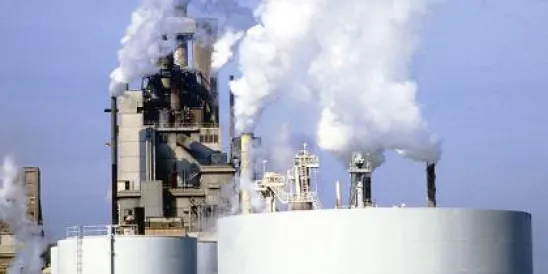On August 3, 2015, the Environmental Protection Agency (“EPA”) issued three separate but related actions to address carbon pollution from power plants: 1) the final Clean Power Plan, President Obama’s signature effort to combat carbon emissions from existing power plants; 2) final Carbon Pollution Standards for new, modified and reconstructed power plants; and 3) a proposed Federal Implementation Plan associated with the final Clean Power Plan.
1. Clean Power Plan
The Clean Power Plan, originally proposed in June 2014, is the country’s first regulation of carbon emissions from existing power plants, issued pursuant to the rarely-used Clean Air Act (“CAA”) Section 111(d). States must follow the rule’s emission guidelines in developing State Implementation Plans (“SIPs”) to reduce carbon emissions from existing fossil fuel-fired electric generating units (“EGUs”).
State Plan Requirements
The final rule establishes two different types of CO2 emissions goals: 1) source-specific CO2 emission performance rates for both coal-fired and natural gas EGUs; and 2) state-based CO2 emission goals, calculated as both a rate-based and a mass-based goal. States may choose to design a program to meet either type of goal.
Under the source-specific goals, coal-fired EGUs must meet an emission performance rate of 1,305 lb CO2/MWh, and natural gas plants must meet a 771 lb CO2/MWh standard. For states whose SIPs rely on these source-specific goals exclusively, each affected EGU within the state must individually meet these performance standards. States that choose instead to meet the state-based goal may design a broader program to meet their specific goal, which EPA calculated by applying the source-specific emissions performance rates to each state’s particular energy portfolio. The individual sources in those states need not each meet the performance standards, as long as the state meets its statewide goal in aggregate.
In meeting emissions targets under either type of program, states may rely on EPA’s determination of the Best System of Emissions Reduction (“BSER”), which EPA has defined as consisting of three “building blocks”:
-
Improving heat rate at affected coal-fired steam EGUs;
-
Substituting increased generation from lower-emitting existing natural gas combined cycle units for reduced generation from higher-emitting affected steam EGUs; or
-
Substituting increased generation from new zero-emitting renewable energy generating capacity for reduced generation from affected fossil fuel-fired EGUs.
Timeline
States must submit final plans by September 6, 2016, although they may request a two-year extension – to September 6, 2018. EPA will review and approve or disapprove state plans within twelve months of submission, meaning the latest date for approval will be September 6, 2019. Affected EGUs will be required to begin to make emissions reductions by 2022, and must meet the final CO2 emission performance rates or equivalent statewide goals by 2030. The final rule contains three interim goals, benchmarked for the periods of 2022-2024, 2025-2027, and 2028-2029.
Changes from Proposal
Although the basic structure of the rule remains the same, EPA has made many changes to the rule since it was originally proposed. Among the most significant changes was the elimination of Building Block 4, which would have included demand-side energy efficiency measures as one element of the BSER. States are still permitted to use demand-side energy efficiency measures as compliance mechanisms in their state plans, but the emissions targets no longer assume such measures will be implemented.
The addition of source-specific emission performance rates also constitutes a significant change from the proposed rule, which only include state-based goals. The source-specific emission performance rates provide a more straightforward option for states that do not wish to develop comprehensive statewide plans. They also provide a mechanism for ensuring that EGUs are subject to the same standards throughout the country.
EPA has also made a number of changes intended to create a smooth “glide path” to compliance. Among these, EPA has also pushed back the interim deadlines by two years. State plans may be submitted as late as 2018, and emissions reductions are not mandatory until 2022. However, the final compliance year is still 2030 under the final rule.
In response to widespread concerns related to the rule’s impact on reliability, EPA has also included a “reliability safety valve” in the final rule, which would allow EGUs to continue operating “in the face of an extraordinary and unanticipated event that presents substantial reliability concerns” even if such operations would be in conflict with the state plan.
Overall, most states’ final emissions goals are less stringent than they were in the proposal. However, due to the methodological changes in calculating the state goals, some heavily coal-reliant states such as West Virginia and Illinois now face more stringent goals than they would have under the proposal.
Trading
Although the proposed rule clearly supported the idea of carbon trading in general, the final rule provides far more concrete detail on trading options. The rule provides mass-based targets, which will be particularly useful for states that wish to create and participate in cap and trade programs. As discussed below, states that do not submit an approvable SIP may by default be assigned to achieve their reductions via such cap and trade programs. Also, states are permitted under the final rule to propose SIPs that allow for interstate trading without formally entering into multi-state plans, which reduces the logistical barriers for states that generally wish to participate in trading but do not want to develop or participate in a formal multi-state plan.
2. New, Modified and Reconstructed Power Plants
The Carbon Pollution Standards for New, Modified and Reconstructed Power Plants, issued under CAA Section 111(b), apply to coal-fired and natural gas-fired EGUs.
Under the final rule, new coal plants will be required to implement Carbon Capture and Storage (“CCS”). In using CCS, they must achieve an emission limit of 1,400 lb CO2/MWh-gross. Coal units implementing large modifications will be required to meet a standard based on their historic performance; units implementing smaller modifications are not subject to a new standard under the final rule. For reconstructed units, EPA has determined that BSER is the performance of the most efficient generating technology for the types of units in question.
For new and reconstructed natural gas EGUs, EPA has determined that BSER is natural gas combined cycle technology. The emission limit is 1,000 lbs CO2/MWh on a gross-output basis for base load units, and non-base load units will be required to meet a clean fuels input standard. EPA is not proposing a standard for modified natural gas units.
Under EPA’s interpretation of the CAA, a 111(b) rule for EGUs is necessary to trigger the authority to issue the 111(d) rule. This final rule therefore not only serves as a stand-alone regulation, but also provides the legal underpinning for issuance of the Clean Power Plan.
3. Proposed Federal Implementation Plan
The Proposed Federal Implementation Plan (“FIP”) would apply to any state that does not submit an approvable plan under the Clean Power Plan guidelines outlined above. As proposed, the FIP establishes a carbon trading scheme as the default regulatory requirement for any state that does not submit an approvable plan. EGUs in states under FIPs could therefore participate in carbon markets that are established by other states or entities for purposes of complying with the rule. Those EGUs could then purchase carbon credits to achieve their required reductions, along with implementing any other on-site measures to reduce their emissions to the required level.
The proposed FIP also serves as a model trading rule for all states to use in their SIPs. States that choose to utilize the model rule in approved SIPs would therefore also be entered into the trading program.
Public comments will be due within 90 days after the proposed FIP is published in the Federal Register.





 />i
/>i

